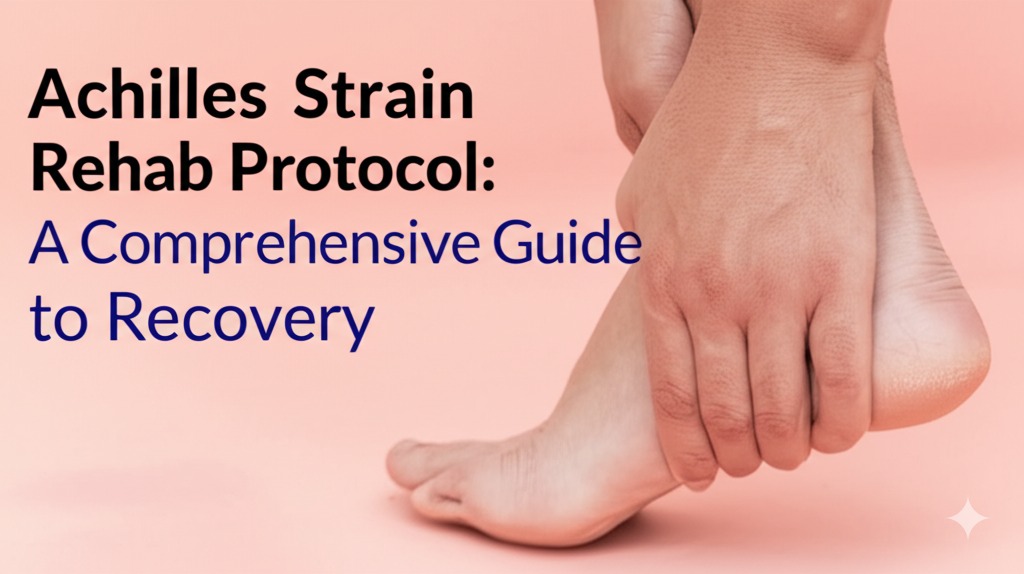Achilles tendon strains are a common injury that can occur due to overuse, sudden movements, or inadequate warm-up. The Achilles tendon, connecting the calf muscles to the heel bone, plays a crucial role in everyday movements like walking, running, and jumping. When it is strained, the road to recovery can be long, but with the right rehab protocol, you can regain strength, flexibility, and function. In this article, we’ll cover the steps and strategies for a successful Achilles strain rehab protocol to get you back on your feet in no time.
Understanding Achilles Strain
What Is an Achilles Strain?
An Achilles strain refers to damage or overstretching of the Achilles tendon, leading to pain, swelling, and limited mobility. It can occur in various degrees, from mild discomfort to a complete rupture. Common causes include sudden increases in physical activity, improper footwear, or insufficient warm-up before exercise.
Symptoms of Achilles Strain
The key symptoms of an Achilles strain include:
- Pain or tenderness at the back of the ankle, especially when walking or running.
- Swelling or bruising around the tendon.
- Stiffness in the ankle, particularly in the morning or after rest.
- Difficulty pointing the toes or performing activities like running or jumping.
Step-by-Step Achilles Strain Rehab Protocol
1. Initial Rest and Ice Therapy (Acute Phase)
In the first few days after an Achilles strain, the primary goal is to reduce pain and inflammation.
- Rest: Avoid activities that stress the tendon, such as running, jumping, or standing for extended periods.
- Ice Therapy: Apply an ice pack to the affected area for 15-20 minutes every few hours to reduce swelling.
- Elevation: Elevate the foot above the level of your heart when resting to minimize swelling.
- Compression: Use a compression bandage to support the tendon and reduce swelling, but be sure it’s not too tight to avoid restricting blood flow.
2. Controlled Mobility (Subacute Phase)
Once the pain and swelling start to decrease, you can begin gentle mobility exercises to maintain range of motion.
- Gentle Stretching: Focus on calf stretches and Achilles tendon stretches. Hold each stretch for 15-30 seconds, repeating 2-3 times.
- Range of Motion Exercises: Perform exercises like ankle circles and towel stretches to improve flexibility without straining the tendon.
- Strengthening: Begin isometric exercises (like gently pressing the foot against a wall) to engage the tendon without significant strain.
3. Strengthening and Gradual Loading (Rehabilitation Phase)
As your tendon heals, it’s crucial to rebuild strength and function through controlled, progressive loading exercises.
- Eccentric Strengthening: Eccentric exercises (slowly lowering the heel below the level of a step) are particularly effective in promoting tendon healing and strength. Perform these exercises 2-3 times a week, focusing on controlled movement.
- Calf Raises: Start with basic calf raises on both feet, then progress to single-leg calf raises as strength improves.
- Proprioception Exercises: Add balance exercises (like standing on one leg or using a wobble board) to restore proprioception and enhance ankle stability.
4. Sport-Specific Rehabilitation (Advanced Phase)
Once strength and mobility are restored, sport-specific exercises can help you return to your usual activities without risk of reinjury.
- Jumping and Sprinting Drills: Begin with light jogging, then progress to sprinting and jumping drills as tolerated.
- Plyometric Training: Incorporate exercises like squat jumps and bounding to improve power and agility, ensuring your tendon is ready for dynamic movement.
- Sport-Specific Movements: If you’re an athlete, focus on drills that mimic the movements of your sport to rebuild performance capacity.
Tips for Preventing Future Achilles Injuries
Preventing a recurrence of Achilles strain is just as important as rehabilitation. Here are a few tips to keep your Achilles tendon healthy:
- Proper Warm-up and Cool-down: Always warm up before engaging in physical activity and cool down afterward with gentle stretching.
- Strengthen Your Calves: Regular calf-strengthening exercises can improve the tendon’s resilience and prevent strain.
- Wear Appropriate Footwear: Choose shoes that offer adequate support, especially during high-impact activities like running or jumping.
- Gradual Increase in Activity: Avoid sudden increases in training intensity. Gradually ramp up your workouts to allow your body to adapt.
Conclusion
Recovering from an Achilles strain requires patience, consistency, and adherence to a structured rehab protocol. By following the right rehabilitation steps, such as rest, mobility exercises, strengthening, and sport-specific training, you can return to full function and reduce the risk of future injuries. If you are dealing with an Achilles strain, consult a healthcare professional or physical therapist to create a tailored plan suited to your specific needs.

Kallie Snyder is an author at Stonegate Health Rehab, providing valuable insights, recovery guidance, and rehab resources to help individuals achieve better health and well-being.
